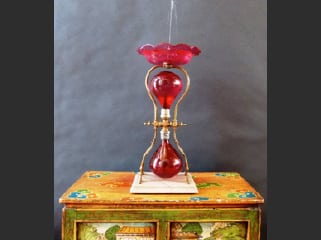
Almost everyone knows what a geyser is and many have seen the famous one at Yellowstone. A much lesser-known man-made invention operating on a similar principle is an automatic fountain that cleverly seems to defy gravity by operating even without the heat source that underlies a natural geyser.
The man-made version, the Automatic Crystal Fountain, was commercialized by John W. Tufts in about 1871 as a novel new product released by his company, Arctic Soda Apparatus of Boston, Massachusetts.
The Automatic Crystal Fountain was a product series, beautiful in appearance and magical in operation. Tuft’s catalog of 1873 advertised it as “… substantial and simple, with no weights, springs, leaky cylinders or complicated arrangement of any kind.” It needs no water pressure or heat sources and yet a mere inversion of the globes results in an 8” fountain-type spray of water above the globes, which lasts for 15 minutes or more. A flip of the globes starts the fountain for another interval.
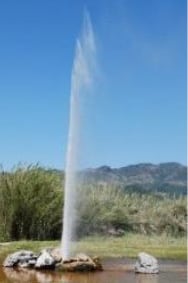
Old Faithful, California
One purpose of the fountain as advertised, in addition to being attention-getting by seemingly making “water run uphill,” was as an air perfumer. By scenting the water with an essential oil, the Fountain could spread a delicate fragrance in a room. The suggested oils, available at any apothecary, or supplied by Tufts, were bergamot, cologne, lemon, bay, cinnamon, lavender, citronella, rose, orange, jasmine and verbena.
Directions for perfuming the water read: “Take 1 teaspoonful of any of essential oils, and mix thoroughly in a glass dish with 1 ounce of carbonate magnesia, then add gradually 3 quarts of water; shake the whole together in a bottle, and filter through filtering paper.”
From the Tufts’ 1871 catalog: “The very large sale of these delightful perfume Fountains during the time I have controlled the patent… are simple evidence of their value …. The basin and globe are of ruby glass, the frame being of rich golden bronze, with polished marble base. Although apparently wonderful, its operation is based upon scientific principles…An ingenious contrivance causes the weight of the water in the basin to compress the air in the cylinders, thus making the motive power which is without mechanism. It is a simple law of hydrostatics practically applied. The extreme novelty of its operation, with the apparent absence of motive-power, ads very materially to its attraction as an ornament, and excites general surprise and wonderment.”
Crystal table fountains were highly ornamental novelties intended for the mansions and emporiums of an ostentatious time. Following the depression of 1893, Tufts, in his “Letter to the Trade,” quoted Motley, the historian, who wrote “Give us the luxuries of life, and we will do without the necessities.”
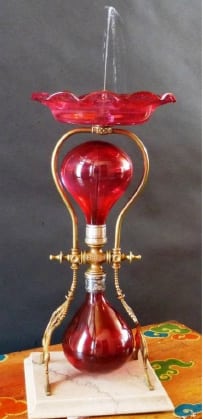
Tufts Automatic Crystal Fountain; Crandall collection
Table fountains certainly qualified as luxuries. The least expensive Tufts version cost $15, which represented more than two weeks’ pay for a typical laborer of the period. “Ruby Glass, Etched” fountains were listed for $20-30.
Tufts also offered a second, much more elaborate and expensive parlor fountain, designated “Style No. 2,” which sold for a staggering $50 (see illustration far right). Only one surviving example of this second style is known. The catalog description states that the fountain “has two basins, the upper one is the reservoir for water which supplies the Fountain and the lower is for flowers, but instead this may be used for gold fish with beautiful effect.”
OPERATION
But how did it work? With no springs, pumps or external “mechanism” of any kind, the fountain was designed to shoot a jet of water 6 – 8″ into the air from a nozzle mounted above the glass basin. This was the time it took all the water in the raised globe to move through a valve at the intersection of the globes, up one side of the fountain’s tube-like frame, out the nozzle as a spray, and then down through the frame from a drain hole in the basin to the lower globe. Rotating the globes at the completion of play restarts the fountain.
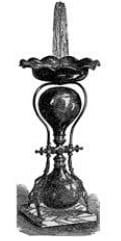
Style No. 1
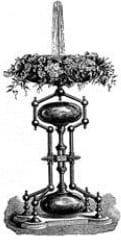
Style No. 2
Fountain illustrations from the circa 1877 Tufts trade catalog
Tufts’ instructions state explicitly that the fountain must be filled by pouring water into the glass basin. This is because the fountain’s motive power comes from air pressure generated by the weight of the water held in the basin.
Geysers operate via this mechanism, although the spouting of the water at the surface occurs discontinuously. Also while the fountain requires that the air supply container be manually emptied of water, geysers have an analogous “air-supply container” that is steadily heated by geothermal energy. When the water level in the air-supply container becomes too high, the geothermal heat causes the water to boil off and therefore naturally empties the container of water and replaces it with water vapor instead of air.
MARKETING
Tufts marketed and advertised his fountains from the mid 1870s until the 1890s. Most of the existing examples are American, made by Tufts. The earliest ads are from the 1876 Crockery and Glass Journal referring to it as an “Automatic Crystal Fountain.’’
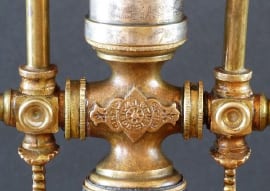
Emblem: Pat. Feb 7, 1871 J.W. Tufts Boston
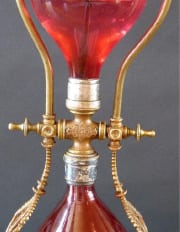
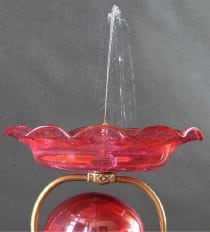
Close-up of rotation detail and fountain “geyser”
Crandall collection
Tufts noted in a circa 1877 trade catalog now in the Rare Books Department at Boston Public Library that his “perpetual” fountain operated on “a simple law of hydrostatics, practically applied.” “The extreme novelty of its operation,” he continued, “with the apparent absence of motive power, adds very materially to its attraction as an ornament, and excites general surprise and wonderment.” Tufts suggested that when perfume is added to the water, the fountain can serve as an air purifier ideal for sick rooms. It also would make an attractive ornament for “the store counter, show-window, parlor, dining room, library, drawing room, conservatory, theatre, ball room, etc.”
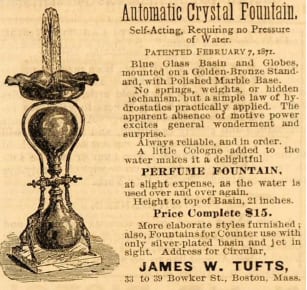
The glass was available in opaque white, plain or with enameling or gilding, colorless, blue and ruby glass all with or without acid-etched decoration. The bases were square white Italian marble or Seveir marble with molded edges. The frames were golden bronze antique bronze silver-plate and fancy gold. So far there are eight in museum and private collections in the United States and several more have come up for auction. There is no evidence that Storer ever manufactured the fountains.
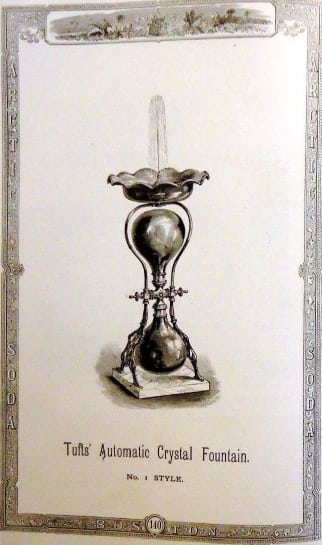
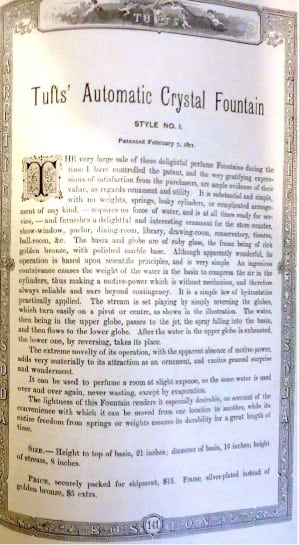
INVENTION
John Tufts didn’t actually invent the Fountain. He purchased the patent rights from Joseph Storer of Hammersmith, England whose patents were issued first in England in 1870 and then in the U.S. in 1871.
On June 7, 1870 Joseph Storer of Hammersmith, England obtained Patent No. 1647 from the English patent office for an “improvement in Fountains” he declared the nature of the said invention to be an improvement in that class of self-acting fountain known as Heron’s fountain, and that his patent:
‘Relates to the application of means whereby the repeated filling and emptying of the cisterns or reservoirs is obviated. ‘
Storer described the two cisterns and their connecting pipes and went on:
“To put the fountain in operation water is poured into the dish or basin until the lower reservoir is filed and the opening is covered. The cisterns are then turned on their axis of motion, so as to place the filled one at the top and the water will flow to a level in the jet pipe and be forced up to the nozzle from which is falls back into the basin and drains down into the lower cistern. When the water has flowed through, a reversal of the resolving cisterns will cause it to start again.”
In the following year, he patented the fountains in the U.S. receiving Patent No. 111,697 on February 7, 1871. The text and the illustrations of the American patent are identical to the London one and does not mention glass for the globes.
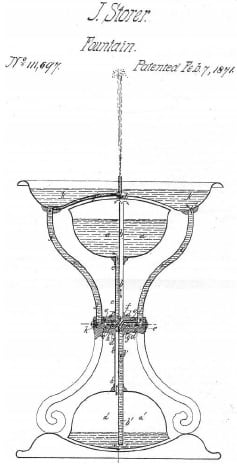
HERON’S FOUNTAIN
Heron of Alexandria in his Pneumatics of about AD 62 described the water-fountain which operated with air pressure and this was illustrated with drawings in several 19th century encyclopedias.
Heron’s fountain is a hydraulic machine invented by the 1st century AD inventor, mathematician, and physicist Heron, also known as Heron of Alexandria. Heron studied the pressure of air and steam, described the first steam engine, built toys that would spurt water, and a fountain. Various versions of Heron’s fountain are used today in physics classes as a demonstration of principles of hydraulics and pneumatics.
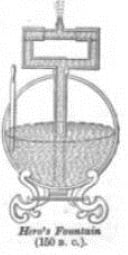
Illustration from Knight’s American Mechanical Dictionary (Boston: Houghton, Osgood & Co., 1880, p. 910), showing the principle of the fountain’s operation as first described by the ancient mathematician and engineer Heron of Alexandria (c.10-70 AD)
Heron’s fountain is built as follows:
- Start with a basin (A), open to the air. Run a pipe from a hole in the bottom of that basin (A) to an airtight air supply container (C).
- Run another pipe from the top of the air supply container (C) up to nearly the top of the airtight water supply container (B).
- A pipe should run from almost the bottom of the water supply container (B), up through the bottom of the basin (A) to a height just above the basin’s rim and becomes the spout. The fountain will jet upwards through this pipe.
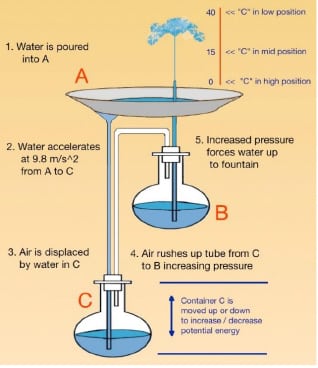
Operation:
- To prepare for start, the air supply container (C) should contain only air; the water supply container (B) should contain only water.
- To start, pour water into the basin (A).
- The water from the basin (A) flows by gravity into the air supply container (C). This water forces the air in (C) to move into the water supply container (B), where the increased air pressure forces the water in (B) to jet out the top as a fountain into the basin (A). The fountain water caught in the basin (A) will drain back to the air supply container (C).
- The flow will stop when the water supply container (B) is empty.
Heron’s fountain is not a perpetual motion machine. If the nozzle of the spout is narrow, it may play for several minutes, but it eventually comes to a stop. The water coming out of the spout goes higher than the level in the containers, but the net flow of water is downward. If, however, the volumes of the air-supply and water-supply containers are designed to be much larger than the volume of the basin, with the nozzle of the spout being narrow, the fountain can operate for a far greater time interval.
The fountain can jet almost as high above the upper container as the water falls from the basin into the lower container. For maximum effect, place the upper container as closely beneath the basin as possible and place the lower container a long way beneath both.
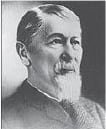 James Walker Tufts (1835-1902)
James Walker Tufts (1835-1902)
Shortly after his father’s death 1851, James was apprenticed at sixteen years of age to the Samuel Kidder Company, an apothecary shop in Charlestown, Massachusetts. His apprenticeship lasted six years.
Shortly after completing his apprenticeship, with the advice and help from his father’s friends, he located and purchased his own drug store in Somerville, Massachusetts. He worked endlessly preparing his own cures and extracts and, four years later, was able to purchase a second store in Medford, Massachusetts. He also purchased drug stores in Winchester, Woburn, and Boston, Massachusetts, creating one of the earliest drug stores chains in the United States.
Tufts began manufacturing items for other apothecaries and, by age 27, had developed a complete line of soda-fountain supplies, including flavored extracts. He also started The Arctic Soda Fountain Company to manufacture his own soda fountain apparatus.
In 1891, Tuft’s Arctic Soda Fountain Company consolidated with A. D. Puffer and Sons of Boston, John Matthews of New York and Charles Lippincott of Philadelphia to become the American Soda Fountain Company with James W. Tufts as the company’s president. In 1895, when Tufts was 60, he sold his part of the business. He died in 1902 at the age of 67.
SOME OTHER EXTANT EXAMPLES
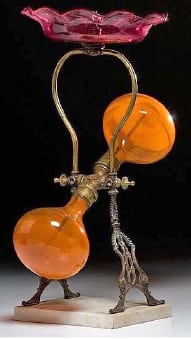
“Automatic Fountain”
Silver-plated brass, iGavel Auctions, Apr, 2004
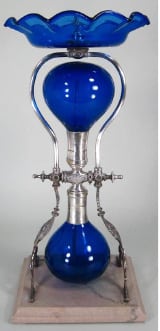
“Automatic Fountain”
Neal Auction Co.,New Orleans, 1994
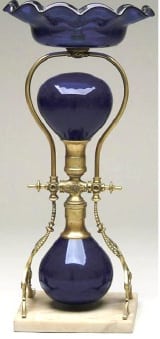
“Automatic Fountain”
VCA auction, January, 2012
SOURCES
- Johnson, Laurence A., The Spinning Wheel, May 1961, p20. Tufts’ Automatic Crystal Fountain
- Boston Public Library, Rare Books Dept., Tufts Trade Catalog circa 1877
- Spillman, Jane Shadel, Corning Museum of Glass, Corning N.Y. The Automatic Crystal Fountain
- Wikipedia, Heron’s Fountain


